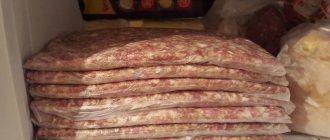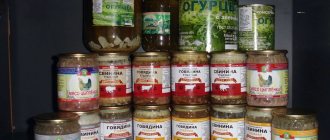What would we do if there was no test? How would you cope without baked goods and your favorite dishes, without bread, dumplings in soup and various pies? Dough is an excellent product with which you can prepare many dishes of varying complexity. It saves us on holidays, helps us set the festive table and treat ourselves to sweets. We get the dough by mixing products - the required ingredients are flour and water, the rest are added depending on what type of dough we are preparing.
There are so many types of test:
- sand,
- biscuit,
- yeast,
- fresh,
- puff pastry
Each is intended for a different type of product - for bread and pastry, for cookies, cakes, rolls. All these types of dough are combined with different fillings - some are perfect, but others are not suitable at all.
Related link: How to store bread
The test has its own shelf life and its own environment. You cannot keep it at room temperature for a long time, especially if it is cooked with yeast. Spoiled dough must not be kneaded or used. To determine that the dough is unsuitable for use, you need to pay attention to its smell - stale dough smells sour, yeast dough smells like yeast. It becomes sticky even after being in the refrigerator.
The shelf life of the test according to the State Standard is from 9 to 36 hours. Dough products have their own shelf life - from 24 to 72 hours at room temperature or in the refrigerator. We will put more detailed information in the table.
| Dough/Condition | Room temperature | Fridge | Freezer | Recommended cookware |
| Yeast (sour) | 1 hour | 1-2 days | 2-3 months | Plastic bag |
| Fresh (yeast-free) | 1 hour | 2-3 days | 6 months | Cling film |
| Puff | 1 hour | 1-2 days | 1-2 weeks | Cling film, container |
| Puff pastry without yeast | 2 hours | 2-3 days | 1 month | Cling film, container |
| Custard | 1 hour | 3 days | 1 month | Cling film |
| Sand | 3-4 hours | 2-3 days | 2-3 months | Cling film, bag |
| Biscuit | 1 hour | 3 days | 6 months | Container with lid |
| Pancake | 2-3 hours | 01 day | 1 month | Pan, container |
Yeast dough
Yeast dough, due to the main ingredient - yeast, spoils very quickly. The fermentation process occurs, the dough sours, and it is no longer possible to use it in cooking.
The shelf life of yeast dough at room temperature is 1-2 hours.
Quick yeast dough must be able to rise, otherwise it will sour due to carbon dioxide. It is not stored at room temperature, but to store it in the refrigerator, it should be thoroughly mixed and placed in a bag, leaving room for rising overnight. This way it will keep for one to two days (depending on the amount of yeast). It is not recommended to store it in the refrigerator for more than one day, because its quality deteriorates noticeably. This dough is not suitable for every baking. Yeast dough for the lazy is dough that has been preserved, and not one that had to be prepared again.
For longer storage (2-3 months), yeast dough can be placed in the freezer. After kneading thoroughly, place the dough in a plastic bag and help it achieve a flat shape.
Important! For freezing, use fresh yeast dough with kefir , which has just been made. The recipe is also important.
If you place the finished dough in the freezer before rising, make sure there is room for this. The bag should be large and there should be enough free space, otherwise, when the dough starts to rise, it will tear the bag.
The sales period for yeast dough is 24 hours, and for products made from it - 72 hours. But you need to be careful with baking, because a lot depends on the filling. Plain buns will keep for 72 hours even at room temperature. If lean yeast dough is used to make pies, then the sales period will be no more than 36 hours, and if it is used to make pizza or samsa, for which mayonnaise and other sour products are used, then such products must be sold no later than 24 hours.
TU 10.71.11-566-37676459-2017 Puff pastry bakery products
The finished product has its own requirements for storage conditions. In the kitchen, the mixture expires after 1-2 hours. There are two places where you can store the product for a long time. This is a refrigerator and a freezer. Each type of semi-finished product requires special storage conditions, time and temperature.
According to the state standard, raw dough can be kept on the refrigerator shelf from 9 to 36 hours. The exact time depends on the type of product or its components. Before you put the semi-finished product on the shelf, you should learn how to properly store the dough in the refrigerator.
- Only small amounts of raw food can be stored on the refrigerator shelf.
- The mass must be thoroughly mixed, collected into one lump, and greased with vegetable oil on top.
- The semi-finished product must be wrapped in cling film, parchment, or placed in a bag. In the case of a yeast mixture, it is very important to leave a small hole for oxygen to enter.
- The mass is placed on the shelf where the temperature is lowest.
You can store the raw product at low temperatures from 1 month to six months. In order for frozen dough to retain its taste, the following conditions must be met.
- The semi-finished product must not be thawed or re-frozen. It is better to divide the mass into parts for one-time use.
- It is necessary to form a dense lump or roll from the mass. A thin layer will quickly lose quality, and products made from such a product will not be tasty.
- All types of semi-finished products must be kept in airtight containers or bags. To avoid sticking, the walls of the container should be treated with refined vegetable oil.
Good day!
For each family holiday, you have to cook a lot for guests. To make the table look more varied, I’ve been preparing salads in tartlets (I’ll share the recipe). Unusual, tasty, and even appetizing.
the tartlets themselves at the “LENTA” hypermarket , under the brand name produced by the same “365 days” . The cost is about 140 rubles for tartlets, there are as many as 32 pieces ! Profitable is not the right word.
Puff pastry
Puff pastry requires the same storage conditions as pizza dough - that is, yeast dough. If it is properly packaged in cling film and then securely wrapped in a bag, then the storage process will not be a problem. It is better to divide the dough into portions - prepare balls, calculate the portions, and pack each of them separately.
If you stored the dough in the freezer and then defrosted it, then you can store it for no more than a day - after long-term freezing, the fermentation process of the products in the dough accelerates, and it quickly deteriorates and sours.
It is also important to monitor the storage of puff pastry products. For example, vol-au-vents without filling can be stored for 7 to 10 days in the refrigerator. If the filling is still present, the shelf life is reduced to 2-3 days.
The shelf life of puff pastry products, such as puff pastry , can be increased if you do not put the filling in advance. For example, if you are preparing a pie, but do not plan to serve it today, but want to put it off for the day, then simply bake the pan itself, and the filling can be prepared and laid out later.
The lead time for puff pastry production depends on many criteria and varies from 2 days to one week.
Experienced housewives have learned to store not only dough, but also finished products made from it. For example, puff pastry tartlets can remain usable for 3 months if stored at a temperature in the refrigerator from +5'C to + 25'C.
How long is the shelf life according to GOST?
GOST 33394-2015 “Frozen dumplings” regulates the production, storage, labeling, transportation and other important nuances of product manufacturing. This instruction applies to semi-finished meat products in dough, that is, frozen dumplings intended for sale in retail chains.
According to the modern GOST standard , dumplings can be of only two categories, and bear the following names:
- Semi-finished meat product category B is a semi-finished product that contains from 60% to 80% meat in the filling (“Elite”, “Beef”, “Val”, “Oriental”).
- Semi-finished meat product category B is a semi-finished product that contains from 40% to 60% meat in the filling (“Russian”, “Siberian”, “Canteen”, “Traditional”, “Homemade”, “Lamb”, “Hunter”, “Pork” , “In Uralian”, “Sabantuy”).
The shelf life of semi-finished meat products is established by the manufacturer, but there are recommended expiration dates according to GOST:
- At temperatures no higher than minus 10 degrees – no more than one month.
- At a temperature not higher than minus 18 degrees – no more than six months.
Compliance with the principles of product proximity, compatibility and storage standards for food products is described in detail in a separate article.
If there is no proper temperature at production, during transportation and in the store, meat preparations cannot be sold at retail outlets. Thawed and re-frozen products are not allowed for sale, since the product loses some of its moisture, which can subsequently lead to a change in the consistency of the product, resulting in a deterioration in the taste of the dough or meat filling.
Staying in the warehouses of transport enterprises, as well as prolonged stay in production warehouses, is not allowed.
GOST 33394-2015 “Frozen dumplings” regulates the production, storage, labeling, transportation and other important nuances of product manufacturing. This instruction applies to semi-finished meat products in dough, that is, frozen dumplings intended for sale in retail chains.
Shortbread dough
To prepare shortcrust pastry, a lot of sugar and butter are usually used, which is why it is so loose and crumbles in your hands.
To preserve this dough, you need to divide it into lumps, roll them up and wrap each one in film. On a shelf in the refrigerator, thanks to the large amount of sugar and butter, shortcrust pastry can be stored for several days. It can also be frozen, divided into portions. By the way, this is the only type of dough that, after freezing, does not lose its beneficial properties, but, on the contrary, becomes more suitable for baking. Try making a pie – you won’t even feel the difference.
How long does a puff pastry product last?
- We take the butter out of the refrigerator in advance so that it has time to soften.
- We wash the eggs and break them into a bowl in which we will prepare the dough. Start whisking with a pinch of salt. You can beat it by hand, but using a mixer is faster and more efficient. The mass should become white and airy.
- Add a third of the sugar. Turn on the mixer again and beat. Then add the remaining sugar in the same way, whisking each time. Finally, beat until you get a light foam.
- Add baking powder. Change the mixer attachment to a spiral hook for mixing the dough.
- We begin to add soft butter piece by piece. Knead in between. Add sifted flour portionwise. Mix with a mixer.
- Place the rest of the flour on a clean table surface. Place the dough on the table and knead the dough with your hands. If the dough remains very sticky, you need to add a little more flour. It should become elastic and smooth.
- Knead well for about five minutes.
Dough is a perishable product. It cannot be kept at room temperature for a long time. Products that contain yeast spoil especially quickly. When unusable, it becomes sticky and acquires a sour odor.
The shelf life of the test should be no more than 36 hours. It can only be kept in the refrigerator for three days.
When preparing shortbread, yeast is rarely used. The composition includes a large amount of butter and granulated sugar. Thanks to these components, it turns out loose and crumbles well in your hands.
To preserve the product, it is divided into portioned lumps. Each is wrapped in cling film. In this form, it can be kept on the refrigerator shelf for three days.
There is a misconception that baked goods are sterile when leaving the oven. Some microorganisms are resistant to high temperatures. There are also risks and possibilities of contamination of products after baking due to the presence of microorganisms everywhere: in the air, on packaging materials and equipment, on conveyor belts. To limit or slow down spoilage, it is necessary to control a number of parameters:
1. Initial microbiological contamination. 2. Technological process (especially baking and cooling). 3. Microbiological purity of the atmosphere after baking. 4. Aw (water activity) of the finished product. 5. Choice of packaging (permeability). 6. Shelf life of the finished product. There are three types of microorganisms: bacteria (bacillus and cocci), yeast (unicellular fungi), molds (filamentous fungi).
Candida Pelliculosa (average Aw: 0.87), Candida Umicola (average Aw: 0.88), Rhodotorula (average Aw: 0.92)
Signs of spoilage, for example, the appearance of an unpleasant “chemical” odor caused by the presence of ethyl acetate, styrene (light cinnamon odor), lipolytic enzymes (can lead to a change in the smell of the filling), can be caused by contamination of even high-precision products with wild yeast, although the Aw of these products is very low .
The staling process begins immediately after the products have cooled. This process is associated with retrogradation (recrystallization) of starch (amylose and amylopectin). As is known, starch in flour is in a crystalline state, then during baking (in the presence of water) it gelatinizes, and during storage the reverse process occurs, the paste turning into crystals. Moreover, at 4oC (very often bread is stored in the refrigerator), the rate of transformation into crystals increases significantly. What can be done to slow down the staling process? Firstly, this is the selection of raw materials. Flour should contain a large amount of high-quality protein. It affects volume, the formation of melting crumb and helps retain moisture. The use of monosaccharides, fats, eggs and special improvers. Secondly, this is the use of special, adapted packaging. Quite often, co-extruded or metallized films are used for this type of product (since these materials have low vapor and air permeability, and metallized films have zero light transmittance).
Main characteristics of shelf-stable puff pastry products (SDIDH): The layering of the product should be undeveloped, compared to traditional puff pastries. Rather, it is porosity rather than layering. This is due, first of all, to the fact that during transportation this product may be damaged (if there is a layered structure). Generally, shelf life is in the range of 1–4 months. SDIDH is produced both without filler and with various fillers (jammies).
Due to the fact that products are subject to long-term storage, the approach to the selection of raw materials is very important. This is due to the development of microorganisms, drying of the product and oxidative processes of fats. The choice of dough making scheme and raw materials must be adapted to obtain the necessary parameters (acidity, softness of the product, taste). Just as for conventional puff pastry products, it is recommended to use flour with increased baking properties (dry protein 13% (gluten 30–32%, alveogram (W (breaking energy) > 320, Ie (elasticity index) = 55, G =20–24, P/L=1).If necessary, you can add dry gluten (from 2 to 4% depending on the quality of flour used), or special improvers based on dry wheat gluten "Mazhimix" with a blue label or "Mazhimix "AM 701. The dosage of salt is in the range of 1.5–2.0%. 1 gram of salt increases the osmotic pressure, like 6 grams of sucrose. Increased pressure creates unfavorable conditions for the development of microbiological spoilage. As is known, glucose (dextrose), glucose syrup , invert sugar, molasses, honey retain moisture better than sucrose and are not subject to crystallization. Therefore, when making SDIDH, it is recommended to replace part of the sugar with monosaccharides (invert sugar, glucose). Since glucose has less sweetness compared to sucrose, it needs to be added more. From the point of view of microbiological spoilage, a higher dosage will have a higher osmotic pressure and, accordingly, a lower risk of microbiological spoilage. The dosage of sugar is usually slightly higher than for traditional puff pastries, it ranges from 15–20% (usually 10%). Just as for traditional puff pastry, it is recommended to use the freshest possible compressed yeast, preferably osmotolerant (due to the increased dosage of sugar) or instant osmotolerant yeast - “Saf-instant gold” (instant) and “Record” with a blue label (pressed yeast ). Experts know that different fats oxidize differently. Due to the fact that the product will be stored at room temperature for a long time, it is recommended to use the freshest special margarines for puffing (you must pay attention to the production date). When using butter, the shelf life of finished products is significantly reduced (faster oxidation compared to margarines).
use of preservatives in dough; preservative/alcohol spray or injection; packaging in an atmosphere of modified gases;
The most common way is to add preservatives to the dough - salts of propionic acid or sorbic acid, both separately and together. In addition to preservatives, alcohol is sometimes used to spray the surface of products. The effectiveness of alcohol depends on its concentration.
Recently, the segment of products with long shelf life has been actively developing on the Russian market. This direction allows manufacturers to have certain advantages when selling products and cover large territories.
Among small-piece products, puff pastry products with various fillings are very popular. Many enterprises have automated/semi-automated puff pastry production lines. The product range produced on these lines usually has a limited shelf life (48–120 hours). There are enterprises where the load on such lines is incomplete. To ensure maximum productivity, a great solution is to produce products that can be shipped over long distances and therefore expand geographically. To accomplish this task, it is necessary to increase the shelf life and take into account two important points: the likelihood of microbiological spoilage of the product and the staling process. Let's take a closer look at all the features of the production of puff pastry products with long shelf life.
Biscuit dough
Biscuit dough is more liquid than the rest; it is almost impossible to store it in a bag. The best storage containers are containers.
It is advisable to use it immediately after preparation - the large number of eggs in the recipe makes it quite perishable and does not allow it to be stored for a long time . But if it is still not possible to use the dough right away, then place it in the refrigerator. Place the dough in a bowl and cover with cling film to keep air out. Or use a container that will hermetically seal the dough from unnecessary odors.
This dough can be stored in the freezer for six months, but to use it, you need to be able to defrost it correctly - first place it in the refrigerator until it becomes soft enough, and only then knead and prepare the cake.
Storage recommendations
Basic rules for extending consumer properties at home:
- Ideally placed on the bottom shelf of the refrigerator or in the freshness area.
- If you realize that you won’t have time to sell the test material before tomorrow, place it in the freezer.
- It is first recommended to cut into pieces, roll in flour or brush with vegetable oil.
- The container must reliably protect the contents from the penetration of foreign odors and airing.
- In order to rationally allocate time, you can prepare a large number of semi-finished products (dumplings, cheesecakes, dumplings) and freeze them in portions.
Play dough
The modeling dough should be the same color, otherwise the molded products will not look decent. You can divide it into parts and put it in the refrigerator , but you cannot store it for longer than two or three days - the dough will darken and become unusable.
There is no point in freezing play dough - after defrosting it loses all the necessary qualities, and if you defrost it several times, mold may form.
Children and adults need to store play dough in plastic bags or cling film - you can use a container for storage, but when cutting off pieces for modeling, try not to let too much air get into the container.
Puff pastry products with a long shelf life
The finished product has its own requirements for storage conditions. In the kitchen, the mixture expires after 1-2 hours. There are two places where you can store the product for a long time. This is a refrigerator and a freezer. Each type of semi-finished product requires special storage conditions, time and temperature.
According to the state standard, raw dough can be kept on the refrigerator shelf from 9 to 36 hours. The exact time depends on the type of product or its components. Before you put the semi-finished product on the shelf, you should learn how to properly store the dough in the refrigerator.
- Only small amounts of raw food can be stored on the refrigerator shelf.
- The mass must be thoroughly mixed, collected into one lump, and greased with vegetable oil on top.
- The semi-finished product must be wrapped in cling film, parchment, or placed in a bag. In the case of a yeast mixture, it is very important to leave a small hole for oxygen to enter.
- The mass is placed on the shelf where the temperature is lowest.
If you want to store the dough in the refrigerator, it should not be stored for very long, as the fermentation process may cause the dough to sour. But if you put the yeast dough in the freezer, it can be stored there for several weeks. The dough should defrost in a warm place, and after it has melted, it should rise again. And after it has risen, you must immediately start cooking with it.
It is better to cut the dough into portions before freezing to make it easier to use.
Certain types of dough can sit on the refrigerator or freezer shelf for a very long time. This applies to unleavened, flaky, yeast-free, custard, honey, ginger and gingerbread products. A prerequisite for such a semi-finished product is the absence of perishable products in the composition.
When frozen, such a mixture can retain its qualities for six months.
To preserve the taste and quantity of nutrients, any products, including dough, should be quickly frozen and also slowly defrosted.
The best way:
- in the evening, remove a portion of the dough from the freezer and place it in the refrigerator;
- keep for several hours at room temperature;
- knead and start cooking.
Semi-finished products, such as pies, dumplings, dumplings, noodles, are immediately placed in the oven or thrown into boiling water.
You can use the microwave for quick defrosting.
The container with the frozen product is placed in a bowl filled with hot water or near the radiator.
Frozen dough can only be reheated once. If re-frozen, it will lose quality.
Thawed mass can be stored for a short period of time. Once defrosted, it should be used immediately.
When storing dough, it is very important to comply with all conditions. It is necessary to monitor the timing, temperature, and tightness of the container. Any housewife can knead or buy ready-made dough, store it on the shelf of the refrigerator or freezer, and delight the family with delicious baked goods for a long time.
Certain types of dough can sit on the refrigerator or freezer shelf for a very long time. This applies to unleavened, flaky, yeast-free, custard, honey, ginger and gingerbread products. A prerequisite for such a semi-finished product is the absence of perishable products in the composition.
It is worth considering that if you neglect the conditions and rules of storage of such a perishable product, it can become unusable in a few hours. But with proper processing, the products can still be suitable for consumption.
- Peroxided . A sour smell appears, the prepared mass begins to settle. This product is absolutely not suitable for the oven, but it can be used, for example, for making “pancakes” or pies in a frying pan.
- Very acidic . This can be understood by tasting the product; the smell is complemented by a distinct bitterness on the tongue. This product is no longer suitable for cooking; it can only be used as pet food.
- It's rotten . This cannot be ignored. The mixture becomes sticky, watery, and also develops a very pungent, unpleasant odor.
- Mold has formed . This is a fairly rare occurrence, but still, sometimes it happens. A crust of mold appears on the surface of the mixture, and there is also a smell of dampness and “swamp.”
Pancake dough
Pancake dough contains milk and eggs, and due to its liquid consistency, it cannot be stored for a long time. The longest shelf life in refrigerator is one day. In this case, it is necessary to periodically open the lid of the pan in which the dough is stored and stir it so that it does not stagnate.
It is better not to store pancake dough at all - if sour milk , then the longer such dough is stored, the more sour the pancakes will taste.
The pancakes themselves are stored in the freezer as semi-finished products for about 2 months.
For pancakes and pancakes
The main component of this mass is milk or fermented milk products, as well as eggs. Therefore, it has the shortest shelf life.
How to save? It is advisable to leave the dough in the refrigerator for no longer than a few hours, a maximum of a day.
The lid on the pan should be tightly closed to limit the flow of air. But even in this case, you need to open the pan and stir the mass so that its consistency is not disturbed.
You cannot store pancake dough in the freezer: during defrosting, liquid will release and you will no longer get a homogeneous composition.
How to properly freeze yeast dough
Is it possible to freeze yeast dough? Yes. If the product needs to be stored for a longer period, the package must be placed in the freezer. In this case, you can squeeze it with your hands so that excess air comes out and the dough takes up less space in the freezer. It will not rise under these conditions and can be stored for up to 2 months.
We answer the question: how to defrost yeast dough?
The defrosting process will take several hours. Experts recommend moving the frozen briquette, which resembles a stone, from the freezer to the refrigerator and leaving it there for a while, for example, overnight. And only when the dough softens, bring it to a warm room so that it “reaches.”
If in this case, after the end of cooking, part of the product turns out to be unclaimed, it can no longer be put back into the freezer.
All of the above also applies to pizza dough: yeast dough is also used for its preparation.
What if there is no refrigerator?
In this case, the dough needs to be “drowned”:
- We wrap it tightly in a plastic bag, then in a second one less tightly, then in a third even more loosely.
- Pour half a bucket of cold water and drop the dough into it.
First it sinks to the bottom and then floats up. People call this dough “drowned” or “diver”.
Once floating, it can be stored for up to 6 hours. If it takes longer, then it should be kneaded, releasing carbon dioxide, and the procedure should be repeated, while replacing the water with fresh water. This will extend the storage time by another 6 hours.
Baking from “recessed” dough turns out to be very loose, airy, tender, and baked products are stored longer.
Dough for dumplings
The finished dough for dumplings is stored in an airtight container (in a container with a lid or in a bowl covered with cling film ) for several days. It all depends on the temperature set in the refrigerator. Three days of storage is the maximum period; on the fourth day it is better not to use the dough for cooking. Do not store at room temperature - it cannot withstand heat.
If you want to store it for a longer period, place it in the freezer. Frozen dumpling dough will keep for 30 days.
Storage conditions and period in the freezer, refrigerator and at room temperature
Most manufacturers indicate on the back of the package the storage time and conditions under which the dumplings can be suitable for consumption.
Do you use expired food for cooking at home?
Yes, the main thing is to process it if it is meat or expired kefir for pancakes.
27.28%
No, it is very dangerous and not useful.
35.49%
If the products have fungus or mold, then we throw them away; if they are a couple of days past their expiration date, we use them for food, even without heat or other treatment.
37.23%
Voted: 2412
Frozen
The recommended humidity at which dumplings are stored for a long period is 50%.
| Storage conditions | Shelf life |
| At room temperature | In the absence of refrigeration, the product cannot be stored for a long time; storage time at room temperature is up to 24 hours |
| In the refrigerator, temperature no higher than 5 degrees | Up to 48 hours |
| In the freezer, at a temperature no higher than minus 18 degrees | Up to six months |
If the dumplings have already been thawed in the store, then you should not refreeze them; it is better to start cooking right away, this way you will be able to preserve the taste and the product will not spoil.
Dumpling dough
Since its structure and consistency are almost the same as that of dumpling dough, the storage methods are the same. By the way, dumpling dough can be used in other ways - not only in preparing this dish. It is almost universal, and if it has been left in the refrigerator a little longer than necessary, you can make flatbreads or bread out of it - frying it will help get rid of the sourness that may appear in sour dough.
Dough recipe for homemade dumplings with vegetable oil
Butter gives the dough excellent elasticity, and it is very comfortable to sculpt from it; it rolls out perfectly and is quite plastic. But, it is important not to overdo it, otherwise the dough will not hold together when sculpting. In order to properly make the dough, follow our step-by-step instructions.
Ingredients:
- Premium wheat flour – 4 cups.
- Egg – 2 pcs.
- Salt – 1 tsp.
- Boiling water – 250 ml.
- Vegetable oil – 4 tbsp. l.
- Sugar – 1 tsp.
Cooking process:
1. Sift the wheat flour into a bowl twice, break 2 eggs into it, add granulated sugar and salt.
2. Knead the mixture with a spoon, slowly and carefully, it will turn out like flakes. Pour in vegetable oil and knead again.
3. Add boiling water and brew the flour, stirring gently with a spoon.
4. When the dough has cooled down a little, you can switch to kneading with your hands, sprinkle the table and hands with flour and get started. Continue working with the dough, adding a little flour if necessary.
5. Well-kneaded dough is the key to excellent dumplings. When you think the dough is ready, wet your hands in oil and knead the dough again. Gather it into a ball, cover with a towel and leave to rest for 30 minutes, this is important for the gluten to swell so that the dumplings do not fall apart. The dough will be soft and elastic at the same time.
Report a bug
Salty dough
Salt dough is used for modeling products. As mentioned above, it is not advisable to store such dough for a long time, because due to cold it loses its color, which is necessary for making figures, and its consistency becomes less elastic. Do not store this dough for more than two days.
Crafts made from salt dough, properly made and heated in the oven, can be stored for years - for example, in almost every home you can find a dough doll or a whistle made during your school years. The main thing is that the place is cool - do not keep the figures near a stove or radiator - they will come apart.
How and how long to store dough in the refrigerator: tips from housewives
There is a misconception that baked goods are sterile when leaving the oven. Some microorganisms are resistant to high temperatures. There are also risks and possibilities of contamination of products after baking due to the presence of microorganisms everywhere: in the air, on packaging materials and equipment, on conveyor belts. To limit or slow down spoilage, it is necessary to control a number of parameters:
1. Initial microbiological contamination. 2. Technological process (especially baking and cooling). 3. Microbiological purity of the atmosphere after baking. 4. Aw (water activity) of the finished product. 5. Choice of packaging (permeability). 6. Shelf life of the finished product. There are three types of microorganisms: bacteria (bacillus and cocci), yeast (unicellular fungi), molds (filamentous fungi).
The optimal value of water activity Aw (that is, its availability) for the growth of pathogenic bacteria (Clostridium and Bacillus) is the limit of 0.98–1.0. When Aw is below 0.9, bacterial growth practically stops. Bacteria are also affected by pH (the optimum for their development is around 5–7.5) and the absence or presence of oxygen. Example Aw for some products: French baguette - 0.98 (crumb) and 0.78 (crust), partially baked baguette - 0.98 (crumb) and 0.98 (crust), toast bread - 0.96, brioche - 0.90.
Candida Pelliculosa (average Aw: 0.87), Candida Umicola (average Aw: 0.88), Rhodotorula (average Aw: 0.92)
Signs of spoilage, for example, the appearance of an unpleasant “chemical” odor caused by the presence of ethyl acetate, styrene (light cinnamon odor), lipolytic enzymes (can lead to a change in the smell of the filling), can be caused by contamination of even high-end products with wild yeast, although the Aw of these products is very low .
Main characteristics of shelf-stable puff pastry products (SDIDH): The layering of the product should be undeveloped, compared to traditional puff pastries. Rather, it is porosity rather than layering. This is due, first of all, to the fact that during transportation this product may be damaged (if there is a layered structure). Generally, shelf life is in the range of 1–4 months. SDIDH is produced both without filler and with various fillers (jammies).
Choux pastry
Choux pastry has a very unusual composition and method of preparation, so before you think about storing it, you need to prepare it correctly.
The consistency is neither dense nor liquid - something in between, so a container with a lid is best for storage. You can first place the dough in cling film, and only then in a container - this way it will last even longer. The dough will keep in the refrigerator for several days, and in the freezer for 1 month.
If you are going to store choux pastry products in the refrigerator or freezer, then try not to put the filling . Let it be just the “frame” of the cake, for example. Finished products, like eclairs , can be stored for up to three days in the refrigerator, and up to a month in the freezer as semi-finished products.
The sales period coincides with the shelf life - if you store it in the refrigerator, then it must be sold on the first and second days, on the third the dough is already stale, although suitable for consumption.
Useful tips
Not only cupcakes can be stored for a long time. Other rich treats will also stay fresh for a long time if you know a few storage secrets:
- As soon as the pastry is ready, immediately remove it from the hot baking sheet. Place baked goods on wooden cutting boards.
- After baking, cover muffins, pies or any other baked goods with a clean, dry cotton towel to prevent dust from getting on the finished product. This technique has several other purposes. It extends the shelf life of homemade baked goods, prevents their premature drying out and loss of taste, and also gives the products greater juiciness. Synthetic fabrics cannot be used - they do not allow air to pass through, and the baked goods will “suffocate”.
- Place long-lasting baked goods in food containers and cover tightly with lids. Do this only after the products have cooled completely. It is strictly forbidden to place hot baked goods in plastic containers, as this leads to condensation.
- Never place baked goods in a warm or humid environment. This promotes rapid spoilage and mold formation.
- If you don’t have suitable size containers at home, you can store pies wrapped in cling film or foil. In the second case, wrap the pies in several layers.
- It is better to store large pies cut into pieces. Pack each separately, wrapped in film or foil. This way the pies will stay fresh longer. Do not stack pies on top of each other to prevent them from sticking, deflating or becoming deformed.
- Hide baked goods with cottage cheese, meat or any other filling in the refrigerator: even in dryness and darkness, they will spoil within a day.
Pancake dough
The consistency of the pancake dough is quite liquid, so it cannot be stored in the freezer - after defrosting, the water will separate and you will get a slurry that cannot be evaporated. The dough will be stored in the refrigerator for two days, and if you add baking powder or soda in the required proportions, this period will increase to four or five days.
The kefir dough is stored for a day, since kefir itself makes it sour; if you store it longer, then the pancakes will turn out sour, which is not everyone’s cup of tea.
Video
| Freezer (months) | Refrigerator (days) | Room t (hours) | |
| Yeast (sour) | 2-3 | 1-2 | 1 |
| Yeast-free (fresh) | 6 | 2-3 | 1 |
| Puff | 1-2 | 1-2 | 1 |
| Custard | 1 | 3 | 1 |
| Pelmennoe | 6 | 2-3 | 1 |
| Sand | 2-3 | 2-3 | 3-4 |
| Biscuit | 6 | 3 | 1 |
| For pancakes | 1 | 1 | 2-3 |
| For pizza | 6 | 2-3 | 1 |
| On kefir | 1 | 1 | 2-3 |
| For pancakes | 1 | 1 | 2-3 |
Different types of dough
- Protein dough is used by fishermen to attract fish. It is sold in specialized stores and is stored in the freezer for about a year in the usual way.
- Diet dough is usually loved by ladies who constantly monitor their weight. It is used to make cookies, which are good for snacks and instead of dinner later. Diet dough is stored for 1-2 days in the refrigerator, and up to 1 month in the freezer.
- Lenten dough is made with water, without unnecessary additives, so it can be stored for quite a long time - about 3-4 days in the refrigerator, and in the freezer - from 3 to 6 months.
- Waffle dough is stored in the refrigerator - shelf life is 2-3 days. The container must be tight and closed; it is impossible to store it in a bag, because such dough is liquid, it will simply spread throughout the bag; you need a thick, deep container with a lid.
- Lagman dough is viscous and elastic; like noodles made from this dough, it is stored in the refrigerator. The period is 2-3 days, then it becomes sour and sluggish, it is possible to prepare something from such dough, but the taste of the dishes will not be the same, since lagman requires fresh dough. Cling film is the best way to store lagman dough.
- Fishing dough (protein) is created in such a way that it remains usable for a long time, but even it should not be left at room temperature for a long time. If you take it fishing, then fill a jar with cold water and put lumps of dough into it, pre-packed in tight bags. This will cool the dough and prevent it from spoiling.
Features of storage of biscuit, puff pastry and butter dough and shelf life
The yeast mixture for pancakes is not stored, but is immediately used for its intended purpose. If you leave it for a while, it will begin to sour, which will affect the taste of the baked goods.
Yeast-free
Due to the large number of eggs, the biscuit dough is not left in the refrigerator for a long time (1-2 days in an airtight container).
To ensure that the baked goods rise and the sponge cake turns out airy and tender, it is recommended to bake from freshly prepared material. Do not freeze.
The unleavened batch will last longer due to the lack of sugar.
This product will easily last for several days in the refrigerator and up to 180 days in the freezer.
The dough for pancakes (or pancakes) has a pourable, liquid consistency and contains milk (or kefir), eggs, sugar, and baking powder.
Therefore, it should be kept at a temperature of +2+4°C for no more than 24 hours.
The container with the contents must be covered with a lid or plastic wrap and stirred periodically, thereby reducing the risk of thickening and separation of the ingredients.
- Michurinsk +7(475-45) 5-09-80
- Michurinsk +7(475-45) 5-14-13
- Moscow
- St. Petersburg +7(812)309-9389
- Novosibirsk
- N.Novgorod
- Kazan
- Ekaterinburg
- Krasnoyarsk
- Voronezh
- Kaliningrad +7(4012) 720-3-40
- Volgograd +7(8442) 780-3-18
- Samara
- Saratov +7(8452) 493-8-73
- Rostov-on-Don
- Krasnodar
- Stavropol +7(8652) 206-1-02
- Tomsk +7(3822) 984-1-28
- Ufa
The finished product has its own requirements for storage conditions. In the kitchen, the mixture expires after 1-2 hours. There are two places where you can store the product for a long time. This is a refrigerator and a freezer. Each type of semi-finished product requires special storage conditions, time and temperature.
According to the state standard, raw dough can be kept on the refrigerator shelf from 9 to 36 hours. The exact time depends on the type of product or its components. Before you put the semi-finished product on the shelf, you should learn how to properly store the dough in the refrigerator.
- Only small amounts of raw food can be stored on the refrigerator shelf.
- The mass must be thoroughly mixed, collected into one lump, and greased with vegetable oil on top.
- The semi-finished product must be wrapped in cling film, parchment, or placed in a bag. In the case of a yeast mixture, it is very important to leave a small hole for oxygen to enter.
- The mass is placed on the shelf where the temperature is lowest.
A simple recipe for dumpling dough without adding eggs
When you run out of eggs at home, or you don’t eat animal foods because of your beliefs, or during Lent, this recipe will be a great solution. Just do not overdo it with flour so that the dough does not become hard.
Ingredients:
- Premium wheat flour – 3 cups
- Salt – ½ tsp.
- Water – 1 glass.
Cooking process:
1. Considering that the recipe has practically one ingredient, its quality is very important, namely the gluten content in the flour. The peculiarity of gluten is that when it absorbs water, it swells. Sift the flour into a bowl twice.
2. Add salt to a glass of water and stir, leave until dissolved.
3. Make a well in the center of the flour and pour in a little water, stirring with a spoon, add water and start kneading.
4. When all the flour is mixed with water, continue kneading the dough with your hands. Knead on the table until the dough becomes homogeneous and smooth and comes away easily from your hands.
5. Beat the dough on the counter, tossing it lightly a few times. Gather the dough into a ball; it should hold its shape and not spread. Cover it with a damp towel and leave it to “disperse” for 20 minutes.
6. The dough is ready, you can make dumplings.
Report a bug











